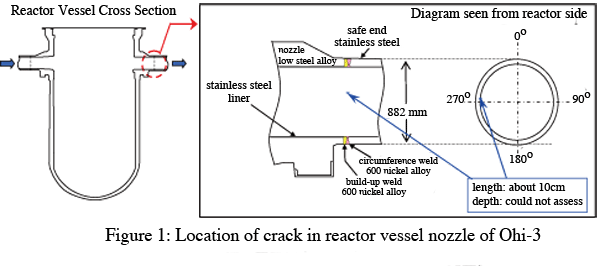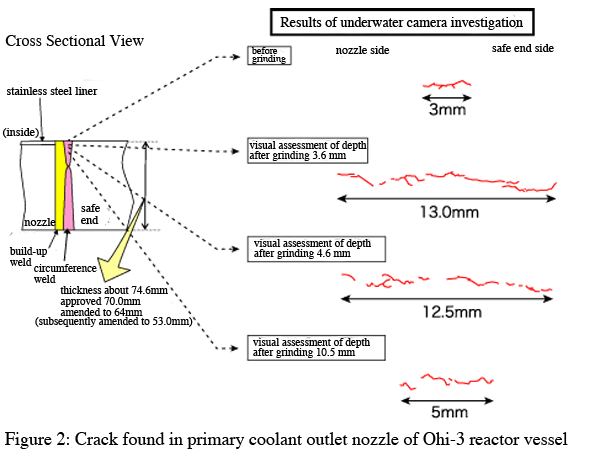SCC in reactor vessels
On April 8, Kansai Electric Power Company (KEPCO) announced that during a periodic inspection of its Ohi-3 nuclear power plant (PWR, 1180MW) a crack was found in a nozzle in the reactor vessel. It is a very serious problem, because if a large quantity of cold water were injected into this location, the crack could open up further leading to the sudden rupture of the nozzle.
The crack was found in a weld on the inside surface of the primary coolant outlet nozzle (nickel Alloy 600) in loop A. The outer diameter of the nozzle is approximately 882mm and the thickness is about 74.6mm. (The license application specified it as being at least 70.0mm.)
The crack was found when KEPCO was conducting eddy current tests in preparation for precautionary measures against stress corrosion cracking (water jet peening) in 4 outlet nozzles (hot leg side) and 4 inlet nozzles (cold leg side) in the reactor vessel (figure 1). From the shape of the crack, it is believed to have been caused by Stress Corrosion Cracking (SCC).

Crack won't disappear with grinding
Later, using an underwater camera, the crack was identified as being 3mm long running along the axis of the inner surface of the nozzle. It was believed to be very shallow, because the depth of the crack could not be assessed with ultrasound tests. However, grinding the surface to remove the crack only revealed that it was longer than it appeared on the surface.
As can be seen in figure 2, after grinding down 3.6mm the crack was 13mm long. When it became clear that the thickness of the nozzle would have to be reduced to less than the approved 70.0mm, KEPCO applied for permission to reduce the allowed thickness to 64.0mm. After grinding down 4.6mm the crack was 12.5mm long. It was still 5.5mm long after it had been ground down 10.5mm. Since it was necessary to grind down even further, on July 16 KEPCO announced that it would again apply for permission to reduce the allowed thickness. Finally, on August 27, KEPCO announced that the crack had disappeared after grinding down 20.3mm. "Just to be on the safe side", it ground a little bit more off. The area in question was then 53.6mm thick, a fraction above the minimum thickness of 53.0mm finally approved by the Nuclear Industrial and Safety Agency (NISA).

Is grinding an acceptable solution?
Over the last few years there have been many reports of SCC in nickel Alloy 600 in pressurized water reactors (PWR).
In October 2000, SCC was discovered in a reactor vessel nozzle in the Virgil C. Summer reactor in the US. Before that SCC was found in reactor vessel nozzles in the Ringhals 3&4 in Sweden. In Japan, SCC in reactor vessel nozzles was discovered in Shikoku Electric Power Company's Ikata-1 in November 2004 and in Ikata-2 in September 2005.
In the Virgil C. Summer case, the crack penetrated right through and caused a leak of primary coolant. The welded section was cut out and replaced with a stainless steel "safe end". In the case of Ikata 1&2, Shikoku Electric removed the cracks by grinding the inner surface and building up the surface by welding over the top with nickel Alloy 690.
Since the depth of the crack did not register on the ultrasound tests, KEPCO presumably concluded that, as in the Ikata case, grinding would suffice for Ohi-3 too. However, KEPCO must have been at a loss what to do when the crack did not disappear after grinding down over 10mm. The fact that the crack was located in the reactor vessel and the fact that non-destructive tests did not reveal the dimensions of the crack are both causes for serious concern.
On August 8, KEPCO announced that its application for permission to grind down a further 10mm over a 11mm (axis) by 13mm (across) area had been approved by the Nuclear Industrial and Safety Agency. But it is not enough to simply remove the crack. Since the mechanism by which the crack arose is not understood, there are no grounds for assuming that the cause has disappeared. Furthermore, how can we be sure that there are no other cracks?
Chihiro Kamisawa (CNIC)

